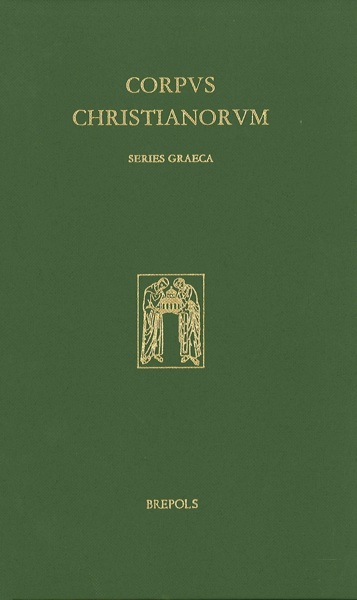
Philippus monachus
Dioptra, Pars I
Prolegomena, Epistulae, Versus apologetici, Programma, Praefationes recentiores, Lamentationes
Eirini Afentoulidou (ed)
- Pages: ccxxxvi + 42 p.
- Size:155 x 245 mm
- Language(s):Greek, German
- Publication Year:2025
- € 220,00 EXCL. VAT RETAIL PRICE
- ISBN: 978-2-503-60516-6
- Hardback
- Available
The present first volume contains the general and text-critical introductions, a complete bibliography, and the critical edition of the introductory Greek texts and the Lamentationes. The main body of the text, along with the indices, will be published in two subsequent volumes.
Eirini Afentoulidou forscht an der Abteilung Byzanzforschung des Instituts für Mittelalterforschung der Österreichischen Akademie der Wissenschaften.
The Dioptra was composed in the year 1095 by a monk named Philippos, who is sometimes referred to by the epithet "Monotropos", an archaising term meaning "monk". Two years after its initial composition, a second redaction appeared, featuring changes in language and meter, as well as textual transpositions.
The main body of the Dioptra consists of four books comprising 7131 "political" verses (or 7217 in the second redaction). These verses take the form of a dialogue between the Soul and the Body, personified respectively as Mistress and Maid. The Mistress poses questions on theological and anthropological issues, which the Maid answers primarily by paraphrasing patristic and biblical passages. A catanyctic poem focused on contrition and penitence serves as either a prologue or an epilogue, depending on the redaction. This section, addressed to the soul, is known as Klauthmoi or Lamentationes. In addition, patristic excerpts collected by Philippos but not versified are transmitted as inserts, appendices or marginal scholia.
The use of “political” verse, the fictional personification of the interlocutors, and the text’s subtle sense of humor set the dialogue apart from the traditional Erotapokriseis genre. These distinctive features, combined with the topics addressed and the clarity of its language, contributed to the exceptional popularity of the Dioptra: no fewer than 80 Byzantine and post-Byzantine manuscripts transmit the work either in its entirety or in excerpts, while an additional nine manuscripts preserve Greek paraphrases.
Die Dioptra wurde im Jahr 1095 von einem Mönch namens Philippos verfasst. Gelegentlich erscheint auch der Namenszusatz „Monotropos" als Hinweis auf den Mönchsstand des Autors. Zwei Jahre danach entstand eine zweite Redaktion, die Eingriffe in Sprache und Metrik, sowie Textumstellungen aufweist. Den Hauptteil des Werkes bilden vier Bücher in 7134 (in der zweiten Redaktion 7217) „politischen" Versen. Sie sind in Form eines Dialogs zwischen Seele und Körper, personifiziert als Herrin und Dienerin, verfasst. Die Herrin stellt Fragen zu theologischen und anthropologischen Themen, die die Dienerin beantwortet, indem sie größtenteils patristische und biblische Stellen paraphrasiert. Je nach Fassung als Prolog oder Epilog der Dioptra ist ein an die eigene Seele gerichtetes Bussgedicht (Klauthmoi / Lamentationes) überliefert. Darüber hinaus sind patristische Exzerpte, die Philippos sammelte, aber nicht in Versform brachte, als Einschübe, Anhänge oder Marginalscholia erhalten.
Die ansprechende Thematik, die einfache Sprache, der „politische" Vers, aber auch die durch die Personifizierung entstandene Fiktionalität, die den Dialog von Erotapokriseis unterscheidet, und nicht zuletzt ein gewisser Sinn für Humor trugen zur ungewöhnlich großen Popularität der Dioptra bei: 80 byzantinische und postbyzantinische Handschriften überliefern die Dioptra als Ganzes oder in Exzerpten. Weitere neun Handschriften überliefern griechischsprachige Paraphrasen.
Der vorliegende erste Band umfasst die allgemeine und textkritische Einleitung, begleitet von einer vollständigen Bibliographie, sowie die kritische Edition der Vortexte und der Lamentationes. Der Hauptteil des Textes sowie die Indizes werden in zwei weiteren Bänden veröffentlicht.





